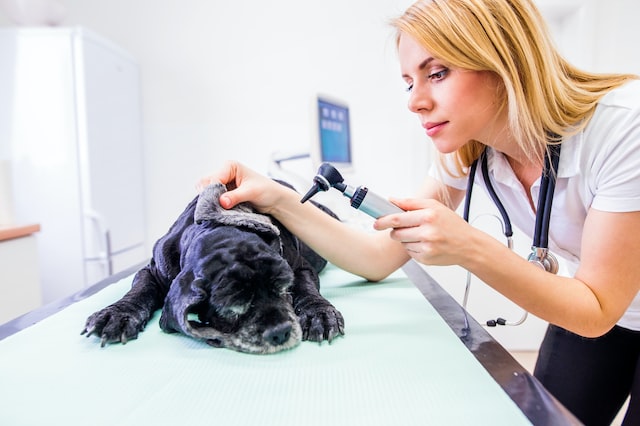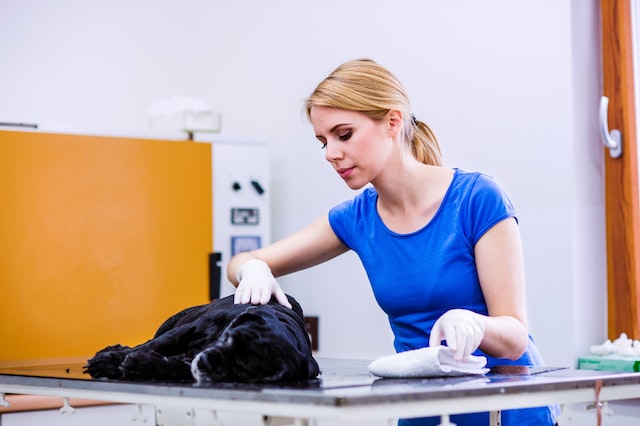A dog’s ear can bleed if it’s infected by a parasite or is damaged by trauma. You may be able to stop the bleeding if you know where to look and what to do. However, if you can’t find a way to treat the ear or you’re not sure how to proceed, here are a few tips to help you get your furry friend back to normal.
Inflammation
If your dog’s ear is bleeding, it’s important to know what to do. Your veterinarian will help you get your pet the care it needs. There are a variety of methods, including medication, surgery and other treatments.
Inflammation in a dog’s ear can occur from many different causes. One common cause is an infection. These can be treated with antifungals, antibiotics and topical medications. However, if your dog has been experiencing chronic bacterial inflammation of the external ear canal, it’s best to see a veterinarian.
After a doctor diagnoses your dog with an ear hematoma, the first step is to prevent the condition from returning. The best way to do this is to follow your veterinarian’s instructions for at-home treatment.
Antibacterial drugs, corticosteroids and topical medicines are often used to reduce the swelling. You can also consider homeopathic remedies. A few of the more popular options include Hamamelis 30C and Arnica montana.
For severe cases, you may need to consult a veterinary surgeon. Surgery will require anesthetic drugs and multiple medical personnel. This is a major procedure, so the cost can be high.

Image by Unsplash+
Ear hematomas can be very uncomfortable to your dog. They can form on the inside of the ear flap and can be hard, enlarged lumps. Depending on the size of the hematoma, it may be painful or resolve itself without treatment.
In most cases, ear hematomas can be treated with topical products. These medications coat the lining of the ear canal with a mixture of antifungals, antibiotics and glucocorticoids. Many dogs recover from these treatments in just a couple of weeks.
Sometimes, a hematoma may require a surgical procedure. In these cases, your veterinarian will perform a procedure called needle aspiration. During this procedure, a small incision is made on the ear flap and a drainage hole is left open. During the next week, your vet will drain the fluid from the ear.
Most dogs can recover from these treatments, although it’s important to keep the ear clean. Keeping your dog’s ears clean will help prevent recurrences.
Parasites
Getting rid of parasites is important to keeping your dog healthy. Not only do they cause health problems to your pet, but they can also spread parasitic infections to you. Fortunately, your veterinarian can help you get rid of parasites safely.
The ear is an area of the body that can be susceptible to a variety of parasites. A dog can have an ear infection due to bacteria, yeast, fungi, or parasites.
If your dog develops an ear infection, it is important to make an appointment with your veterinarian. Your vet will be able to determine the causes and prescribe medications to cure the problem.
It is also important to follow your veterinarian’s instructions for at-home care. For instance, you may need to change the way your dog consumes water. This will prevent the risk of another hematoma developing in the other ear.
In addition to checking your dog’s ears for signs of an infection, your vet can also test for the presence of parasites. Having these tests done annually will ensure you know what your pet is exposed to.
The most common parasites in dogs are roundworms. These worms are extremely easy to transmit. They are typically contracted by grooming or by contact with soil or other surfaces.
Ear mites can also cause an ear infection. The small, spider-like parasites live in the ear canal and can cause a red, irritated ear. Without treatment, these mites can lead to secondary ear infections.
Lastly, a dog’s ear can be damaged by trauma. Trauma can occur from shaking your dog’s head, a grooming accident, or even from normal activities.
You should immediately take your dog to the veterinarian if your dog has bleeding from its ear. Most of the time, the problem will resolve on its own. However, if the bleeding is severe, it is best to have it checked out.
Parasites can cause serious damage to your dog’s ear. As long as you take proper precautions, you can keep your dog free from these parasites.
When you do notice that your dog’s ear is bleeding, try to apply pressure to the wound to stop the bleeding. If this fails, wrap a towel around the area to prevent further bleeding.
Fungal infections
If your dog’s ear is bleeding due to fungal infections, there are a few things you can do to stop it. You may also want to seek treatment from a vet.
Fungal infections are caused by fungi that are naturally found on the skin and ear of dogs. Bacteria and parasites can also cause ear infections.
There are two types of ear infections: otitis externa and otitis interna. Otitis externa is a more serious infection of the outer ear canal, while otitis interna affects the inner ear. Dogs with otitis interna can have difficulty staying on their feet, and they may tilt their heads toward the side infected with the infection.
The best way to treat ear infections is to take your dog to the veterinarian. They will be able to diagnose the infection and prescribe the appropriate medication.
If your dog has a fungal infection, you may need to use anti-fungal medications. These can be oral or topical. Anti-fungal treatments are generally prescribed for 6 to 8 weeks.
In order to prevent fungal ear infections, you should clean your dog’s ears on a regular basis. After bathing your pet, wipe down the ears with cotton balls. This will help to dry the ear canal and avoid excess moisture.
If your dog’s ear is bleeding, apply pressure to the wound. Applying a cotton swab or gauze to the wound will help to stop the bleeding. Try to minimize bandaging, as too much bandaging can impede healing.
Your vet can also perform a series of tests to determine the underlying causes of your dog’s ear infection. Blood testing, x-rays, and MRIs are often required.
Once your dog’s ear has been treated, you should return to your veterinarian for regular recheck appointments. Failure to follow these instructions can lead to a recurrence of your dog’s infection.
Yeast infections are very common in dogs. They can be a sign of an underlying condition, such as hyperadrenocorticism. Other conditions that can predispose a dog to yeast overgrowth include inhalant allergies, food allergies, and hormonal conditions.
Trauma
When your dog has a ear injury, you need to take him to the vet immediately. If you can, you should try to stop the bleeding before you go. In some cases, you may even be able to prevent the wound from opening.

Image by Unsplash+
Some of the most common reasons that your dog’s ear is bleeding are trauma and a clotting problem. If your dog has a clotting disorder, it will be at a higher risk of developing ear hematomas.
In a hematoma, blood vessels break, causing bleeding into the ear space. It can be painful and cause swelling. However, in many cases, the wound will heal on its own without treatment.
There are two main ways to stop the bleeding from a dog’s ear: by applying pressure or by taking him to the vet. You can apply pressure by putting a towel around the wound.
You can also apply styptic powder to the cut. Or you can use a silver nitrate stick or a cauterizing powder. Then wrap the ear with a bandage or a cotton pad. This will help to lock in the harmful bacteria and reduce the bleeding.
Another way to stop the bleeding is by removing the foreign object in the ear. A small object in the ear canal can cause pain, and if there are any abnormal growths, the wound will not be completely healed.
Depending on the size of the hematoma, your vet will perform different treatments. He or she will drain the fluid and clean the ear canal, and may also give your dog medications to reduce the inflammation.
Surgical management is only needed for severe cases. Your vet will insert sutures to remove dead space, and will thread multiple sutures through the ear. After a few weeks, your vet will remove the sutures.
To prevent reopening the wound, your dog will need to be kept in a small room. Until your vet arrives, you can try wrapping the ear in a bandage.
The most important thing to remember when your dog has an ear injury is to stay calm. Your dog’s head tends to shake, and this will only make the bleeding worse.
